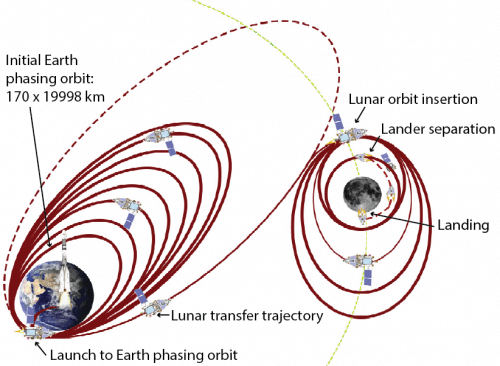The first Indian spacecraft planned to land on the moon has reached a preliminary orbit around it, at the end of September a lander and an all-terrain vehicle will separate from it that will land at the 70 south latitude

India's Chandrayaan 2 mission left Earth orbit, and by firing its engines moved to orbit the Moon.
The Indian Space Research Agency (ISRO) reported that the launch of the engines, known as a translunar launch, took place last night (August 14) and lasted 1,203 seconds.
The spacecraft should enter lunar orbit in less than a week. The mission includes a spacecraft that will remain in orbit and circle the moon for a year. At the beginning of September, the lander and the lunar rover will land and spend one lunar day on the moon (14 Earth days), after which the spacecraft is expected to stop functioning due to the conditions of the lunar night.
Chandrayaan 2 was launched on July 22 this year following the Chandrayaan 1 orbiter launched by India in 2008 and which orbited the moon for almost a year. This spacecraft carried the device that detected frozen water ice below the surface of permanently shadowed craters near the lunar poles. The current mission aims to test that discovery by landing the Vikram lander and the Pragian all-terrain vehicle on a high plain between two craters, Manzinus C and Simpelius N, at a latitude of about 70 degrees south.
The Moon provides the key to Earth's early history. It offers a historical record of the internal environment of the solar system without the disturbances that exist on Earth. Although scientists have direction and even models, the origin of the moon still needs further explanations. Extensive mapping of the lunar surface for research that will detail the variation in the composition of the lunar surface is essential to our knowledge of the evolution of the Earth. Evidence of water molecules discovered by Chandrian 1, requires further studies on the degree of distribution of water molecules on the surface, below the surface to investigate the source of lunar water.
The south pole of the moon is particularly interesting because the shadowed surface area of the moon is much larger than that of the north pole. The south pole region has craters that create cold traps and contain an icy record of the early solar system.
If all goes well, Chandrayaan 2 will also make India the fourth country to successfully complete a soft landing on the moon, following the Soviet Union, the US and China. Israel tried to join these ranks in April in the Genesis mission, but the spacecraft collided with the moon after a malfunction in the landing process.

One response
Leave, the teddies must have already put the Israeli flag there